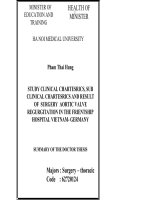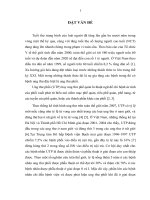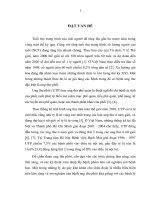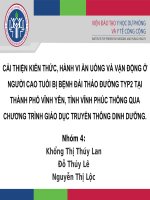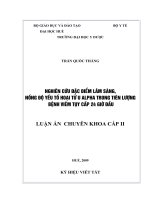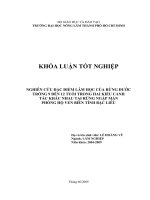Luan an tom tat (anh) nghiên cứu đặc điểm lâm sàng, cận lâm sàng của nhồi máu não ở người cao tuổi có bệnh đái tháo đường
Bạn đang xem bản rút gọn của tài liệu. Xem và tải ngay bản đầy đủ của tài liệu tại đây (491.06 KB, 27 trang )
MINISTRY OF EDUCATION AND TRAINING
MINISTRY OF NATIONAL DEFENSE
108 INSTITUTE O F C LINICAL MEDICAL AND
PHARMACEUTICAL SCIENC ES
NGUYEN THE ANH
STUDY O N CLINICAL AND PARAC LINICAL O F
ISCHEMIC S TRO KE IN THE ELDERLY PATIENT WITH
DIABETES
Speciality: Ne urology
Code: 62720147
SUMMARY O F MEDICAL DO CTO RAL THESIS
HA NO I - 2018
Re se arch comple te d at:
108 INSTITUTE O F C LINICAL MEDICAL AND
PHARMACEUTICAL SCIENC ES
Scientific Supervisors:
1. Prof. P hD. Le Quang Cuong
2. Prof. P hD. Hoang Van T huan
Reviewer 1:
Reviewer 2:
Reviewer 3:
T he doctoral thesis will be defended at the Public Defence At on
A t hesis can be found at:
1. Nat ional Library of Vietnam
2. Library of 108 Milit ary Central Hospit al
1
BAC KGRO UND
Brain stroke, a fat al and disabling disease which is common
among elderly and is an developmental problem. Each year there are
about 15 million people suffer from stroke, of which 5 million die
and ot her 5 million are disabled. Ischemic stroke takes about 80-85%
of stroke. Ischemic stroke (IS) occurs when blood supply to part of
the brain are blocked, causing necrosis of the respect ive brain t issue.
T here are lot s of fact or that lead t o ischemic stroke and diabetes is
one of the most common. In 2015, there are about 415 million people
with diabetes worldwide, 90% of which are type 2 diabetes, and the
rat e of diabetes among people aged 60-79 is 25.9%. Diabetes
increases the risk of atherosclerosis by 2-3 times and doubles the risk
of stroke compared with normal people. The rate of ischemic stroke
in pat ients with diabetes is about 25-40%. Patients with diabetes also
experience
co-occurring
risk
factors
such
as
atheroma,
hyperlipidaemia, hypert ension, which t ogether cause early, severe
ischemic stroke and slower recovery. In Vietnam, there hasn’t been
any study on ischemic stroke that specified in elderly with diabetes.
Hence our research: “Stu dy on clinical and paraclinical
characteristics of ischemic stroke in th e elderly wi th diabete s”.
T here are two object ive:
1. Research on neurological characteristics, m etabolic syndrom es
and magnetic resonance imaging of ischem ic stroke in the elderly
with diabetes.
2. Consider the association between diabetes and cerebral
infarction in the elderly.
2
NEW MAIN CO NTRIBUTIO N O F THE THESIS
- T his is a prospect ive, descriptive, controlled study which
systematized clinical, biochemical and imaging characteristic of
ischemic stroke in elderly with diabetes. T he results are described in
detail, and are compared with patients with non-diabetic ischemic
stroke.
- T he study utilized analytical algorit hms to assess the role of
diabetes and related parameters such as blood glucose, HbA1c,
NIHSS score, Glasgow scale upon hospit al admission and met abolic
syndrome t o t he outcome of ischemic stroke in the elderly.
O VERALL LAYO UT
T his thesis consist of 130 pages including: Background (2
pages), Chapter 1: Lit erature review (35 pages), Chapter 2: Subject s
and methods (19 pages), Chapter 3: Results (30 pages) Chapter 4:
Discussion (41 pages), Conclusions (2 pages), Recommendations (1
page).
T his thesis also consist of 42 tables, 10 graphs, 1 diagram, 9
images, 172 references including 43s in Vietnamese, 129s in English
and 2 related art icles.
*Acronyms: IS-ischemic stroke.
CHAPTER 1: LITERATURE REVIEW
1.1. Abou t ische mic stroke
1.1.1. De fi niti on and cl assifi cati on of ische mic stroke
T he occurrence of IS is the consequence of a sudden decline in
cerebral circulation due t o part ial or total cerebral art ery occlusion.
3
Clinical manifestations of IS are sudden appearances of focal
neurologic signs.
1.1.2. Cause s of ische mic stroke
According to T OAST ischemic stroke causes can be categorized
int o five major group: major vascular disorders, cardiac disorders,
small vessel disorders, other causes and unknown causes.
1.1.3. Clinical manife stati ons
Sudden onset of focal neurologic sign depends on t he size and
location of the injured art ery, including hemiparesis, sensory
disorders, speech disorders, facial paralysis, convulsions, disorders
of consciousness. In addition, clinical severity was assessed using t he
NIHSS scale, with sequelae assessed using a modified Rankin scale.
1.1.4. Imaging diagnosis tools
- MRI is a method with high sensitivit y, surpass computerized
tomography in t he diagnosis of IS.
- Other tests also play roles in the diagnosis of IS, such as
Doppler ultrasound of ext ernal carotid artery, elect rocardiography,
biochemistry t est etc.
2.1. Ische mic stroke in e lderly wi th diabete s
2.1.1. Abou t diabete s
- Diabetes is a chronic metabolic disorder, with genetic fact ors.
T he disease is characterized by increased blood glucose. T he main
cause is absolute or relative insulin deficiency which in t urn leads t o
impaired glucose, protein, lipid and minerals met abolism. T here are
four main types of diabetes: type 1 diabetes, type 2 diabetes and
gestational diabetes and other specific t ypes of diabetes.
4
- Insulin resistance is a decrease in the biological response to
insulin, usually expressed by an increase in insulin levels in the
blood. Insulin resistance is considered to be one of the primary
defect s leading to the onset of type 2 diabetes. Insulin resistance is a
central factor in metabolic syndrome. Met abolic syndrome has six
major components: abdominal obesity, atherogenic dyslipidaemia,
hypert ension, insulin resistance, proinflammatorystates ,
- Vascular complication in patient with diabetes. Cardiovascular
diseases, especially atherosclerosis, are major causes of disability
and deat h in people with diabetes. It significantly increases the risk
of progressive coronary artery disease, cerebrovascular disease and
other peripheral arterial diseases.
2.1.2. Nati onal and inte rnati onal re se arch e s re late to the sis
-Diabetes is one of the leading independent risk factors of IS. The
risk of stroke in people with diabetes is two t imes higher than that of
ordinary people.
- Age, previous strokes, atrial fibrillation, art erial hypert ension,
smoking, dyslipidaemia, hyperglycaemia, durat ion of diabetes are
risk fact ors of IS.
- T he rat e of acute onset of IS, lacunar stroke and stroke due t o
cerebrovascular disease was higher in the diabetic group than t hat of
the non-diabetic group. T he incidence of hippocampal stroke and
posterior cerebral art ery stroke is also higher in the diabetic group.
- T he rat e of first-trimester disability (on t he Rankin and Bart hel
scale) of stroke patient was higher in diabetic group than that of nondiabetic group.
- HbA1c were not associat ed with outcomes of ischemic stroke.
5
CHAPTER 2: SUBJECTS AND RESEARC H METHO DS
2.1. Locati on and durati on of th e re se arch
- Locat ion: T hanh Nhan Hospit al, Ha Noi.
- Duration: From November 2011 t o May 2015.
2.2. Subje cts
Patients aged 60 years and over who were diagnosed with
cerebral ischemic stroke (IS) and treated in T hanh Nhan hospit al.
- Research group: Diabetic stroke patients.
- Controlled group: Non-diabetic stroke patients.
2.2.1. Eligibility cri te ria
- Patients aged 60 years and over
- Hospit alizat ion within the first 48 hours of symptom onset.
- Diagnostic criteria for cerebral ischemic stroke (IS)
+ Clinical crit eria as defined by t he World Healt h Organization
(1989): a clinical syndrome consisting of rapidly developing clinical
signs of focal (or global in case of coma) disturbance of cerebral
funct ion lasting more than 24 hours or leading to deat h with no
apparent cause other than a vascular”
+ Diagnostic Imaging Criteria: MRI was performed within the
first 48 hours of symptom onset. MRI revealed IS: isointensity or
low signal intensity seen at T 1 imaging, high signal int ensity seen at
T 2 imaging or FLAIR, restrict ed diffusion on DWI.
- Diagnostic crit eria for diabetes as defined by American
Diabetes Associat ion (ADA) 2010 , are any of the following:
+ A random plasma glucose of 200 mg/dL (11.1 mmol/L) or
higher in a patient with symptoms of hyperglycaemia or
hyperglycemic crisis.
6
+ A fast ing plasma glucose (FP G) level of 126 mg/dL (7
mmol/L) or higher. Fasting is defined as no caloric intake for ≥8 hours.
+ A 2-hour plasma glucose level of 200 mg/dL (11.1 mmol/L)
or higher during a 75g oral glucose tolerance t est (OGT T ).
+ HbA1c ≥ 6.5%.
2.2.2. Exclusion cri te ria
- Patients with haemorrhage-ischemic stroke.
- Patients with IS accompanied by cerebrovascular malformation
or brain tumours.
- Patients were t reated with t hrombolytic therapy.
- Patients with a history of stroke with sequelae of grade 1 or
higher on a modified Rankin scale.
- Patients with a history of mental disorders and / or traumatic brain.
2.3. Re se arch me th od
2.3.1. Research design: Prospective descriptive comparative crosssectional study
2.3.2. Sample
Sample calculation :
n=
- Z2 (1- α/2 ): Confidence interval 95%, α = 0.05
Z2
(1- α/2 )
= 3.8416.
- p=0.314: the rate of diabetic stroke patients in the previous study
- d=0.1: T he absolute error rate of research results from the sample in
comparison t o t he population.
- n: study sample
Accordingly n=83. In fact, we selected 112 patients in the study
group (diabetic stroke patients) and 103 patients in the comparison
group (non-diabetic stroke patients).
7
2.3.3. Data colle cti on me th od
2.3.3.1. Clinical data
We used uniform medical records for all patients in the study
- History of present illness: Ask the patient and his relatives
carefully about the onset (t ime/date; circumstance: at rest , on
exert ion, sleeping, waking up, psychologically stressed, taking a
bath). Are there any symptoms like change in mental status,
weakness, paralysis, numbness, headache, dizziness, nausea, blurred
vision.
- Medical history: Ask about history of diabetes, hypert ension,
lipid disorders, cerebral stroke, transient ischemic attack, heart
diseases, atrial fibrillation, atrial fibrillation, heart failure, valvar
heart diseases and ot her medical conditions.
- Physical examination
+ Neurological examination: assessment of impairment of
conscious level, hemiplegia, sensory disorders, language
disorders, cranial nerve paralysis, visual disturbances, dysphagia,
convulsion, sphincter dysfunct ion. Assessment of clinical
severity in t he NIHSS scale.
+ Medical examination:
* Measurement of height, weight, waist circumference,
obesity assessment based on body mass index (BMI)
according to World Health Organization (2004) crit eria for
Asia Pacific region Ocean.
* Blood pressure measurement, classifying hypert ension
according to JNC VII
* Det ect ing comorbidities.
8
2.3.3.2. Paraclinical data
- Biochemical blood tests were done at the department of
biochemistry in T hanh Nhan Hospit al. All patients were t ested for
blood glucose immediately aft er admission and repeat ed fast ing
plasma glucose at 6am, after no caloric intake for at least 8 hours. In
the comparative group, in order to distinguish newly diagnosed with
diabetes and reactive hyperglycaemia, HbA1c and twice fast ing
plasma glucose t est were done.
- Head MRI was performed in the department of Radiology in
T hanh Nhan hospit al using Magnet om C 0.35 T esla produced by
Siemens.
+ Signals: T 1W, T 2W, FLAIR, T 2*, DWI, T OF
+ Planes: horizontal, vertical sections. 5mm t hickness for each
slide (parameters of Magnet om C)
+ Results were interpret ed by radiologist.
+ Dat a collection: anatomical location, size, number of new
infarcts; location and number of old infarcts; location and number of
lacunar infarcts.
+ Other investigation: Complete blood count, urinalysis, electrocardiogram, carotid Doppler ultrasonography, echocardiography,
chest X-ray.
2.3.3.3. Diagnosis
- Clinical diagnosis
+ Lacunar infarction
+ Part ial anterior circulation infarct
+ T otal anterior circulation infarct
+ Posterior circulation infarct
9
- Diagnosis of comorbidities and combined syndromes
- Met abolic syndrome: NCEP: AT P III 2005 Diagnostic Crit eria
for Met abolic Syndrome. Presence of three or more of these
components:
+ Abdominal obesity: Increased waist circumference: male ≥ 90
cm, female ≥ 80cm
+ Elevated T riglycerides ≥ 150 mg/dL (1.70 mmol/L).
+ HDL-cholesterol < 40 mg/dL (< 1.04 mmol/l) for male, or <
50 mg/dL (< 1.3 mmol/l) for female
+ Systolic blood pressure ≥ 130 mm Hg or diastolic blood
pressure ≥ 85 mm Hg of medical history of hypertension treated with
antihypert ensives
+ Fasting plasma glucose ≥ 5.6 mmol/L
- Comorbidities: heart diseases, pneumonia, renal failure et c.
2.3.3.4. Assessment of outcome after treatm ent based on m odified
Rankin scale :
- Good: Rankin 0, 1, 2, 3;
- Bad: Rankin 4, 5, 6.
2.4. Analysis and proce ssing of data
- Using the medical statistical method. T he data was checked,
filt ered before import ing and analysed by SPSS 22.0 software.
- Using chi-squared test, fisher's exact test, t-test Student/MannWhitney test; ANOVA/Kruskal Wallist test. OR, 95% confidence
int ervals, and statistically significant at p <0.05.
10
CHAPTER 3 RESEARC H RESULTS
3.1. Clinically neurological characteristics, metabolic syndrome and
MRI findings of ischemic stroke in e lderly patients wi th diabete s
3.1.1. Clinically n e urological ch aracte risti cs
- Ge neral fe atu re s: 215 patients with ischemic stroke, aged ≥ 60
years old
+ Research group (ischemic stroke patients with diabetes): mean
age was 71.30±6.68; rat e of female/male was1.43; the number of
patients aged from 60-74, 75-84 and over 85 accounted for 69.64%;
25.89%, 4.46%, respectively.
+ Comparative group (ischemic stroke patients without diabetes):
mean age was 71.72±7.80; rat e of female/male was 1.01; the number
of pat ients aged from 60-74, 75-84 and over 85 accounted for 64.8
%; 27.18 %, 8.74%, respectively.
+ T here was no differences in age and gender between t wo groups
(p >0.05)
- Clinical symptoms
Chart 3.4. C linical symptoms on admission
11
%
Chart 3.5. Lacu nar syndrome s
Comment: In diabetic group, clinical symptoms on admission
included: hemiplegia 79.46 %, cranial nerve palsy 79.46%,
hemianesthesia 41.07%, aphasia 40.18%, dysphagia (30/80 patients)
37.5%, visual impairment 31.25%, less common symptoms including
disturbances of consciousness 11.61%, sphincter dysfunct ion 8.93%.
T he rat e of patients presenting with dysphagia and visual impairment
in diabetic group was higher
than t hat of comparative group (p<0.05).
Comment: In diabetic group the rat e of pure motor hemiparesis was
41.42%, sensorimotor stroke 18.57%, pure sensory stroke 14.28%,
Ataxic hemiparesis 8.57%, Dysart hria-clumsy hand syndrome
7.14%. T here was no differences in rat e of lacunar syndromes in two
groups (p>0.05).
12
3.1.2. Metabol ic syndrome s
Table 3.15. Rati o of patie nts wi th me tabol ic syndrome s
Groups
Metabolic
syndromes
Number of
Yes
patients
Diabetic Non-diabetic
group
group
Total
87
44
131
Percentage
Number of
patients
77.68
25
42.72
59
60.93
84
Percentage
Total
22.32
112
57.28
103
39.07
215
No
p
0.0001
Comment: The rate of patient with metabolic syndrome in diabetic
group was 77.68% that was higher than data of non-diabetic group
(p<0.001).
3.1.3. He ad MRI findings
Table 3.16. Locati on of infarcts on h e ad MRI
Groups
Locations
Supratentorial
Cortex
Diabetic group
Non-diabetic group
Number Percent- Number Percentage
of patient age of patient
9
8
7
6.21
Subcortical
Infratentorial
(brain stem, cerebellum)
72
64.28
0
8.25
16
14.28
9
8.73
Multiple locations
15
13.43
7
8.05
Total
112
100
103
100
p
< 0.05
Comment: In diabetic patients, the rat e of subcort ical infarction
accounting for 64.28% was the highest, the rat io of brainstem
infarction was 14.28%. T he rat e of multiple infarcts and cortical
13
infarction were 13.43% and 8%, respect ively. There was a difference
in distribution of infarct s in head MRI between diabetic patients and
non-diabetic patients (p<0.05).
Table 3.20. Locati on of lacunar i nfarcts
Groups
Diabetic patients Non-diabetic
p
patie nts
Number Pe rce nt- Number Pe rcentLocati ons
of
age
of
age
patie nts
patie nts
Basal nuclei, internal
21
30
16
35.03
>
capsule
0.05
Corona radiate,
16
22.85
13
28.88
centrum ovale
T halamus
16
22.85
8
15.55
Brain stem,
17
24.28
8
15.55
cerebellum
T otal
70
100
45
100
Comment: In group of diabetic patients, the rat e of lacunar infarcts in
basal nuclei and int ernal capsule, brain stem and cerebellum were
30%, 24.28%, respect ively followed by data of corona radiata,
centrum ovale accounting for 22.85%, and of t halamus (22.85%).
T here was no difference in locat ion of lacunar infarcts in two groups
(p > 0.05).
3.2. The re lati onship be twe e n diabete s and ische mic stroke
3.2.1. Characteristics of history of diabetes and some risk factors
- In diabetic patients, t he rate of hypert ension was only 4.46%,
the rat e of hypert ension combined with elevated LDL-C was
35.71%, the rate of hypertension combined with elevated LDL-C and
14
transient ischemic attack was 29.46%, the rat io of hypert ension
accompanied by elevated LDL-C and history of stroke was 33.93%,
the proportion of hypert ension coexisting with one risk fact or was
43.75%.
- T he rat e of patients diagnosed with diabetes for less than 5 years
and more than 5 years were 23.21% and 76.79%, respectively. Mean
time was 8.3 ±3.72 (years). T he rat e of diabetics treated with
injectable medicat ions was 50%.
- Mean plasma glucose level on admission was 11.24 ± 5.71 mmol/l
in comparison to data of non-diabetic patients that was 6.06 ± 1.43.
3.3.2. The re lationship betwe e n diabete s and ische mic stroke
Table 3.26. The association between ti me of diabete s diagnosis
and outcome
Good
O utcome
Time of
Number of
patie nt
Pe rce ntage
Bad
Number of
patie nt
p
Pe rce ntage
diagnosis
Less than 5
years
≥ 5 years
OR (95%CI)
22
84.6
4
15.4
50
58.1
36
41.9
0.014
3.96 (1.21-12.97)
Comment: Ischemic patients who had a diagnosis of diabetes for
more than 5 years were 3.96 times are more likely to have worse
outcome than those diagnosed with diabetes for less than 5 years.
T his correlat ion is statistically significant (OR = 3.96, 95% CI:
1.21-12.97).
15
Table 3.28. The re lationship betwe e n plasma glucose l e vel on
admission and outcome
Outcome
Glucose
(mmol/l)
Diabetic
patients
Good
Bad
Number of Percent- Number of Percentpatient
age
patient
age
<7.8
≥ 7.8
18
54
OR (95%CI)
Non-diabetic <7.8
patients
≥ 7.8
OR (95%CI)
79
1
52.9
16
69.2
24
0.50 (0.21-1.16)
85.9
13
9.1
10
60.77 (4.45-829.00)
p
47.1
30.8
0.098
14.1
90.9
<
0.01
Comment: In t he group of diabetic patients, t he risk of having bad
outcome in patients with plasma glucose level on admission ≥7.8
mmol/l was 0.5 times lower than that of those who had plasma glucose
level on admission less than 7.8 mmol/l. However, this was not
statistically significant (OR = 0.5; 95%CI: 0.21-1.16). In non-diabetic
patients, the likelihood rat io was 60.77 (OR=60.77, 95%CI: 4.45829.00).
Table 3.29. The re lati onship be twe e n HbA1c and outcome
Outcome
HbA1c (%)
<7
≥7
OR (95%CI)
Good
Bad
Number Percentage
of patient
21
63.6
51
64.6
Number of
patient
12
28
0.96 (0.41-2.25)
Percentage
p
36.4
0.926
35.4
Comment: Among ischemic patients with diabetes, t he likelihood
rat io of having bad outcome of patients with HbA1c ≥ 7 was 0.96
times lower t han t hat of those with HbA1c < 7. However, t his was
not statistically significant (OR = 0.96, 95%CI: (0.41-2.25).
16
Table 3.36. Multi variate l ogisti c re gre ssion model
Characteristics
History of diabetes
<5 years
OR
Bad outcome
95%CI
p
1
-
-
≥ 5 years
5.51
1.58-19.18
0.007
60-74
≥ 75
1
3.24
1.27-8.22
0.014
<5
1
-
-
Age
NIHSS
≥5
3.00
1.26-7.12
r2 =14.57%, p<0.01
0.013
Comment: T he results of t he multivariat e logistic regression model
were adjusted for factors such as history of diabetes, stroke,
infect ious disease, age group, t reatment, history of atherosclerosis
and NIHSS. A history of diabetes, age group and NIHSS were
related to treatment outcome according to Rankin. Accordingly,
those with a history of diabetes for 5 years or more were 5.51 t imes
more likely to have bad outcome t han t hose who had a history of
diabetes less than 5 years, and the associat ion was statistically
significant ( OR = 5.51, 95% CI: 1.58-19.18, p <0.01). T hose aged
75 and older were 3.24 times more likely to have bad outcome t han
those in the 60-74 age group, and the association was statistically
significant (OR = 3.24, 95% CI: 1, 27-8.22, p <0.05). P atients with
NIHSS 5 and above had a 3.00-fold risk of bad outcome compared
with t hose had NIHSS under 5, and the association was statistically
significant (OR = 3.00, 95% CI: 1.26-7.12).
17
CHAPTER 4: DISCUSSIO N
4.1. Ne urological characteristics, metabolic syndrome and magne ti c
re sonance imaging of ischemic stroke in the e lderly wi th diabete s
4.1.1. Ne urological ch aracte risti cs
General characteristics of the study population
According to Huong Phan T hi, the mean age of the elderly
patients was 70,85±6,8, with patients aged from 60 to 74 accounting
for 72,6%. She found that the IS incidence of diabetes patients
peaked at 60 to 74, accounting for 54,55% with the female/male ratio
was 1,2. Alicia Nacu found that the mean age of IS patients
with/without diabetes was 72,6±12,6/70,3±15,2. T he results of t his
trial are consistent with other author’s.
Clinical m anifestations at hospital admission
T ruong-Giang T ruong found that among the clinical
manifestations at admission of IS patients with diabetes, the
proportion of hemiparesis was 86,5%, hemisensory deficit s 62,5%,
skull nerves palsy 85,4%, and visual field deficits 37,5%. T hanh-Son
Ngo concluded that the manifestations of IS with diabetes at hospit al
admission: hemiparesis, hemisensory deficit s, VII nerve palsy, and
dysart hria were common symptoms (87,96%, 51,58%, 42,59%,
26,89%). Hemiparesis and hemisensory deficits incidences in this
trial are lower than those of other authors as t he high prevalence of
patients ran MRI led to more cerebral microinfarcts diagnosed with
no lacunar symptom. T he dominance of visual field deficits and
dysphasia aft er stroke in IS patients with diabetes compared to t hose
without diabetes in this study reflects multi-location ischemic lesions
in diabetes patients, especially the infrat entorial region. Besides,
odonto-stomatology diseases, hypert ension are also factors
contributing t o t he increase of dysphasia.
18
Lacunar stroke
According to many other studies, about 90% lacunar stroke
manifests by lacunar stroke syndrome, in which motor hemiparesis
accounted for 45-57%, pure sensory stroke 7-18%, mixed
sensorimotor stroke 15-20%, ataxic hemiparesis 3-18%, and
dysart hria/clumsy hand 2-6%. T hus the results of this study are
consistent with those of other authors: lacunar stroke is more
common in diabetes patients than t hose without diabetes, with t he
dominance of the classical lacunar stroke syndrome and pure motor
hemiparesis is the most common sign.
4.1.2. Metabol ic syndrome
Metabolic syndrome incidence in type 2 diabetes patients was
59% and increase with ages (T hanh-Duc Le), less that of Bhat tarai S
et al. (71%). T his rat e in IS patients was 71,9% (T huy-Lieu Chau
T hi) and in the elderly was 69,1% (Sadd M.A.N). T he presence of
metabolic syndrome in atherosclerosis patients, even without
diabetes, define the risk of IS or transient ischemic attack (T IA)
(Koren-Monag). To conclude, the results of t his study are similar t o
those of other studies. T he interesting point is t hat t he metabolic
syndrome incidence of the patients without diabetes is relatively high,
proving that metabolic syndrome plays an import ant role in IS in
patients without diabetes.
4.1.3. He ad magne ti c re sonance i mage
T he infarctions in the elderly occur along the vascular
distribution: in the suprat entorial region, anterior cerebral art ery
11,8%, middle cerebral art ery 73,6%; in the infratentorial region,
basilar art ery 9,7% (Hoa-Binh Le Thi). T he infarction rate in acute
phase of IS in the supratentorial region was 77,8%, infra-tentorial
19
region 13,%, and multilocation infarction 9,2% (Vuong Nguyen
Van). In diabetes patients, t he incidence of ischemia in t he cort ical
region was 1%, subcort ical 76%, brainstem 30,2%, mixed infarction
13,5% (T ruong Giang). T he rates of subcortical and brainstem stroke
of diabetic patients are higher than non-diabetic patients
(Karapanayiot ides T H). T hus, our study results are consistent with
the results of other authors: among diabetic patients, IS occurs
mainly in the suprat entorial region; the rat es of cort ical,
infrat entorial, and mixed infarctions are higher than that of the nondiabetic group. In addition, diabetes damages multiple blood vessels,
so t hat the incidence of multiple art ery CIs in patients with diabetes
is higher t han t hat of non-diabetic patients.
T he distribution of lacunae is mainly in the subcort ical white
matter, accounting for 90% and there is no difference in t he lacunar
location distribution between diabetes and non-diabetes groups
(T ruong-Giang T ruong). Palicio found that the lacunar distribution in
diabetic group was as follows: int ernal capsule basal nuclei 26%,
corona radiata and centrum ovale 19%, t halamus 23%, brainstem,
cerebellum 32%. T he lacunar distribution in t he non-diabetic group
was: internal capsule basal nuclei 29%, corona radiata and centrum
ovale 27%, thalamus 22%, and brainstem 22%. Homel et al found
that the lacunar distribution on MRI was as follow: basal ganglia and
int ernal capsule 35%, corona radiata and centrum ovale 19%,
thalamus 14%, brainstem, cerebellum 26%. T hus, our study results
are consistent with the results of other authors regarding the lacunar
distribution, and there is no difference in the lacunar distribution
between t he diabetic and non-diabetic groups.
20
4.2. Relations between diabetes and ischemic stroke among the
e lderly
4.2.1. Diabetes history and some risk factors for ischemic stroke
T ruong-Giang T ruong found that among IS patients with
diabetes: patients with no risk factor account for 4,2%, hypert ension
84,4%, dyslipidemia 70,8%, stroke 37,5%, transient ischemic at tack
(T IA) 30,2%, hypertension combined with other risk fact ors 81,2%.
Paola Forti found that the risk fact or distribution among the elderly
IS patients is that: hypert ension 69,4%, cardiovascular diseases
15,6%, stroke history 23,1%. So, our study results are consistent with
most of the other studies on the two leading risk factors for IS, which
are hypert ension and dyslipidemia. We also found the higher
prevalence of brain stroke and T IA in the diabetes group, similar to
T ruong-Giang’s result.
4.2.2. Relations between diabetes and ischemic stroke outcome s
Time of diabetes diagnosis and patient outcomes
T he prevalence of adverse outcomes in IS patients with the
diabetes history over 5 years is 3,81 times higher than that of patients
with the diabetes history less than 5 years (T ruong-Giang Truong,
OR=3,81, 95% CI: 1,32-11,01). T he risk of stroke in diabetes
patients increase 3% per year, compared to t hose without diabetes
(Liao C.C, OR: 1.03; 95% CI, 1.02-1.04). Due to most of the patients
in our study are aged and have diabetes type 2, which could have
been insidious for 8 - 10 years, they are more likely to have
complications of the vascular system, kidney, thus, have poorer
outcomes.
Blood glucose at admission and patients outcomes
In IS patients with no history of diabetes, t he incidence of the
adverse outcome at hospit al release of the group with admission
21
blood glucose > 7.8mmol is higher than that of the group with
admission blood glucose of 7,8 mmol/L or less. However, in IS
patients with diabetes, t here is no significant difference in this rat e
(T han-Son Ngo). Duc-Hanh Nguyen T hi and Anh-Nhi Vu found
that among IS patients with the history of diabetes, the blood glucose
at the admission does not affect the mort ality rat e as well as t he
recovery degree in the first month. Yao Ming stated that t here is a
remarkable relation between increased fast glucose and the NIHSS
score as well as the adverse outcome among pre-diabetes patients,
but not in diabetes patients. Although there were studies on the
influence of increased glucose level on the short -term and long-term
progress of IS, perhaps there are many other factors affecting t he
progress of IS in diabetes and non-diabetes patients that we have not
known yet.
Glucose level control and patient outcome
According to Duc-Hanh Nguyen T hi, among IS patients with
the history of diabetes type 2, there is no statistically significant
relation between HbA1c and the mort ality rat e and recovery rate at
hospit al release. Jing J. found that in IS patients, there is no relat ion
between HbA1c at the admission and the morbidity rate at hospit al
release and the adverse outcome aft er one year. T herefore, the result
of this study is consistent with t hose of other authors: t here is no
relation between the HbA1c concentrat ion and the outcomes at
release.
Multivariate analysis of the cerebral-infarction-related factors
Duc-Hanh Nguyen T hi and Anh-Nhi Vu found that age, NIHSS
score at hospit al admission, the durat ion of diabetes affect outcomes
of the IS patient with diabetes at discharge. Kaarisalo MM using a
22
logistic regression analysis showed that high age, sex, and history of
diabetes was a predictor of the risk for adverse outcome aft er stroke
(OR = 1.51; 95% CI1.27). -1.81). Viti Kothari found that the
durat ion of diabetes, age, sex, smoking, systolic blood pressure, and
atrial fibrillation were factors associat ed with the treatment. T h.
Karapanayiot ides used a multivariat e regression analysis and found
that adverse outcomes aft er discharge of diabetes patients are
associat ed with ages, NIHSS scores at admission but unrelated to
hypert ension. Adrià Arboix argues that the predictors of adverse
outcome and mort ality in hospital in pat ients with IS include the age
of the patient, levels of consciousness at hospit al admission, chronic
kidney disease, congestive heart failure and atrial fibrillat ion. So, our
study is consistent with the results of other authors: old age, history
of over 5 years of diabetes and NIHSS score at admission increased
the risk of adverse outcomes aft er discharge of t he IS patients with
diabetes.
CO NC LUSIO N
Aft er conducting research on 215 ischemic stroke elderly patients
with diabetes, I have come t o t he conclusion:
1. Ne urological characteristics, metabolic syndromes and
magnetic resonance imaging of ischemic stroke in th e elderly
with diabetes
- T he most common clinical signs were: hemiparesis (79.46%),
hemisensory (41.07%), language disorder (40.18%), dysphagia
(35.71%), visual impairment (31.25% ). T he rate of dysphagia and
visual impairment in diabetic group was higher than that of nondiabetic patients, p <0.05.
23
- Lacunar infarction presented in 62.5% of ischemic stroke
patients with diabetes in which: t he rate of pure motor hemiparesis
was 41.42%, mixed sensorimotor 18, 57%, hemisensory 14.28%,
weakness and coordinat ion impairment 8.57%, clumsy-hand
dysart hria 7.14%, other syndrome 10%. T here were no differences in
lacunar syndrome between t he t wo groups.
- T he incidence of metabolic syndrome in patients with diabetes
was 77.68%, higher than non-diabetic group (p <0.001).
- In diabetic patients, the cort ical infarction rat e was 8%,
subcort ical 64,28%, 14.28% in the brainstem, 13.43% in multiple
locations. T he difference was statistically significant when compared
to non-diabetic group, p <0.05.
- In diabetic patient, lacunar stroke in the basal ganglia and
int ernal capsule accounted for 30%, brainstem and cerebellum
24.28%, corona radiata and central ovale 22.85%, thalamus 22.85%.
2. The re lation between diabetes and ischemic stroke in e lderly
patie nt
- In patients with ischemic stroke, 5 or more years history of
diabetes was associat ed with poor outcome at discharge(OR = 3,96,
95%CI: 1,21-12,97).
- In patients with diabetes there was no associat ion between
elevated blood glucose at discharge and poor outcomes at
discharge(OR = 0,5, 95%CI: 0,21-1,16), while in t he non-diabetic
group there is (OR=60,77, 95%CI: 4,45-829,00).
- Results of multivariat e analysis: history of 5 years and above of
diabetes, age of 75 years and above and NIHSS score at admission of
5 and above was associat ed with poor outcomes at discharge.
